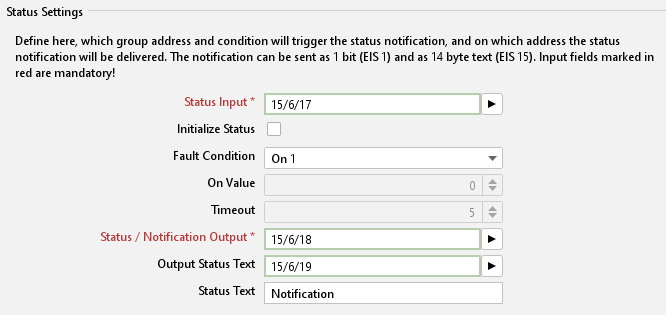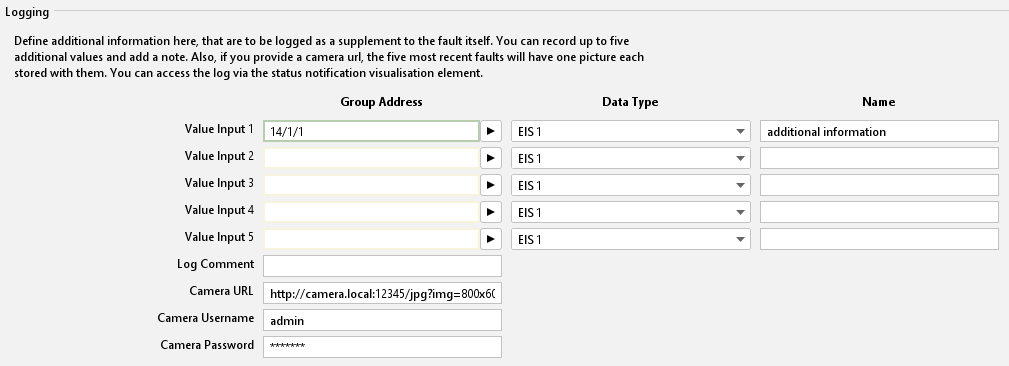Status indicator

The job status indicator processes status changes in form of 1 bit or 1 byte telegrams on status messages which can be acknowledged and recorded. With the corresponding "Status indicator" visualisation element (see chapter ”Status ”) the job can be used in the visualisation. Thus, complete status indicator processing can also be used in CONTROL L.
Job Name
Required field. Assign a unique name for the job. The name must not contain more than 15 characters.
Enable object
The enable object enables or disables the job. It is an EIS 1 object:
Group address not assigned = job enabled
Group address entered, value 1 = job enabled
Group address entered, value 0 = job is disabled
Group address entered, no value = job is disabled
As soon as an address is entered into the field, the enabling will respond according to the value of the group address. If no value has yet been sent to the address, i.e., it is without value, the job is disabled.
Status settings
Define here which group address and conditions are to trigger the status message and via which address the status change is to be reported.

Job status indicator – Status settings
Status input
Input for detecting a fault
Initialise status
If this option is enabled, the job sends its current state when it is re-initialised. E.g., after the job is saved or after the device is re-started.
Error condition
Which state indicates a fault/error condition. Possible options are:
1
0
Rising edge
Falling edge
A pre-set fixed value (EIS14)
Generally, each value change
Timeout – If there are no incoming telegrams on the status input within a pre-set period of time, the error condition is triggered.
Error indicated by value
This field is enabled if the items "Value" or "Value change" are selected under Error condition. Define here the reference value for the selected condition.
Error after timeout (min.)
Field is enabled if "Timeout" is selected under Error condition. Define here the timeout value in minutes.
Status / message output
The status is reported on this group address. EIS 14 (1 byte) value. Meaning:
Value = 0 means "OK"
Value = 1 means "fault"
Value = 2 means "acknowledged"
Value = 3 means "fault disappeared unacknowledged"
Status text output
Optionally, a text can be sent as well when an error occurs. The text is deleted after the error has been eliminated. Data type: EIS 15 (14 byte)
Note: Please note that if several jobs share a group address for the status text, the text will be deleted after only one of the errors has been eliminated.
Status text
The field is enabled if a valid group address has been entered in "Status text output". Enter here the status text which is to be transmitted.
Acknowledgement settings
You can define up to 5 group addresses incl. acknowledgement text for acknowledging the status change here. An added acknowledgement text helps you to identify the acknowledging body. At least one acknowledgement address must be defined.

Status indicator – Acknowledgement settings
Acknowledgement text output
The corresponding acknowledgement text is sent on this address (#1 - #5) (depending on which of the 5 acknowledgement addresses are used). Data type: EIS 15 (14 byte).
Reset acknowledgement
The acknowledgement of a fault will be cancelled after this interval in minutes provided the fault has not yet been eliminated.
Acknowledgement #1 - #5
It is possible to store up to five group addresses for one acknowledgement. For each group address, an individual text can be stored which is sent via the "Acknowledgement text output" group address. In addition, faults can be acknowledged via the visualisation element. In this case the logged in user is used as text.
Logging
This feature can be used to define additional information which are to be included in the log. Besides the actual status events, up to 5 additional values and a comment of any type can be stored. If a camera URL is entered, one camera image is stored as well for each of the 5 most recent faults. The log data can be accessed via the "Status indicator" visualisation element. The visualisation element saves up to 100 log entries.

Status indicator – Logging
Value input 1 – 5
Define here the value input addresses #1 - #5 with group address, data type (EIS 1, EIS 5) and name. At the time of the event (status change), the current value of the specified group address and the specified name are saved in the log file. Value object data type: EIS 1 (1 bit) and EIS 5 (2 byte)
Log comment
Use this field to transmit any additional information for the log.
Camera URL
Enter here the complete URL required by the EIBPORT to call up the still image of the desired camera. For example: "http://[IP address of the camera]:[port number]/image.jpg". If access is protected by a password, please specify the camera user data in the corresponding fields.
Camera user name / camera password
The http basic authentication of the camera.
